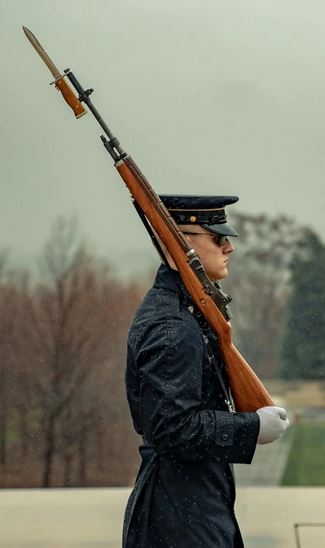I saw this pic, and my first thought was: why does the U.S. military use this silly “slope arms” position?

For those who’ve never had to march with a rifle, here’s my gripe: that trigger guard is going to keep digging into your collarbone, and after a while that is going to be owie.
Far easier, in my experience, to hold the rifle side-on, with the trigger guard on the “outside” (away from) the neck.

The grip on the rifle is more secure (the left wrist is horizontal rather than vertical, as above), similar to the way one would do curls with weights in the gym: the biceps work better that way, ask any lifter.
More importantly, the “sideways” slope arms accommodates a longer magazine because it lies on its side along the upper body instead of once again digging into the body.
I welcome comments from those who know more about U.S. military drill than I do.

That first pic is not really representative. Those Tomb of the Unknown guys are completely hard core and, for them, the discipline/pain of carrying that way is probably some of the point. They are not marching, but providing a vigilance and, for those than come to watch, a show (sacrilege, but true). I find the contrast interesting between these Tomb guys with their 60-yo wooden stock M-14 rifles and bayonets versus the Buckingham Palace guards with their 18th century costumes and their modern bullpups that look like toys. The anachronism is just jarring. Of course, I feel the same way about the Tomb Guard’s sunglasses.
https://commons.wikimedia.org/wiki/File:Buckingham-palace-guard-11279634947G5ru.jpg
https://tombguard.org/guards/weapons
I don’t have a problem with the sunglasses, because snow blindness is a Very Bad Thing. You may as well object to the gloves…
I schlepped an SLR (aka FN-FAL) in the Australian army for a decade. We didn’t have slope arms, we had “Shoulder arms”, and you marched along carrying the weapon by the pistol grip in the right hand, tucked against the body.
Here you can see the “Salute to the front” drill movement comparing how it was performed with the .303 to the then newly introducesd SLR.
https://www.alamy.com/new-rifle-drill-for-british-army-the-old-and-the-new-on-the-left-is-the-lefthanded-salute-with-the-new-rifle-at-the-shoulder-arms-in-contrast-with-the-right-handed-salute-with-the-old-rifle-at-the-slope-seen-on-right-a-demonstration-of-proposed-alterations-in-drill-caused-by-the-adoption-of-the-self-loading-belgian-fn-30-rifle-for-the-british-army-was-given-at-the-school-of-infantry-at-warminster-wiltshire-the-drill-was-demonstrated-by-squads-of-the-1st-battalion-wiltshire-regiment-and-recruits-form-the-guards-depot-caterham-surrey-december-13-1954-image471436845.html
This position enabled drill to be performed with a magazine on the weapon. When on a large scale parade, we always placed a few coins in the magazines. A thousand men doing “Present Arms” made a hell of an impressive noise.
Oddly enough, I miss those days. Hard times make strong men. Infantry soldiering has losts of hard times, and it made me strong, and that has stood me in good stead through a difficult life.
LSW, that position on the left of the pic is what drives me scatty. The charging handle of the FN sticks into your side as you march, and after a while you get a “parade bruise” that just gets more painful over time.
Don’t ask me how I know this. (SADF 1977-79)
The sensible Australian Version of the SLR had a spring loaded folding charging handle that snapped neatly out of the way upon being released. Problem averted.
That pik is a ceremonial thing. I did 4 years in the army in the 70’s and rarely did we carry an M16 in that upright position. Maybe a half hour total in 4 years.
Like pointy toed, high heeled women’s shoes, it’s all about looking smart, not comfort.
or utility.
And like most things military, “It’s tradition” or “It’s policy; it doesn’t need a reason”.
(22 years in the U.S. Navy. If there’s an organization more bonded to “tradition” I’ve yet to hear of it.)
I was not in class the day my Property Professor thundered out, “Reason? Hell, there is no reason, it’s just the Law.” What with the patchwork of laws gradually added to American Property law over the centuries (and English property law before that), the professors have to work hard to pretend that it all makes sense and hangs together logically. This is especially hard in Constitutional Law.
The military has never been noted for common sense, at least up until existential issues come to the fore.
Never been in the service, but have carried a rifle and bear gun a fair ways. Carry the damn thing anyway that is comfortable and quick to get into action. Usually at the balance point in the hand, or over the shoulder by the barrel.
The sensible Australian Version of the SLR had a spring loaded folding charging handle that snapped neatly out of the way upon being released. Problem averted.
Interestingly this point appears to have come up 81 years ago. In “Home Guard Drill and Battle Drill” (John Brophy, 1943, quoted in a collection of extracts of British Home Guard training manuals I have, there is the following.
“Note:- The American rifles with which many Home Guard units are equipped are not altogether comfortable at the slope, and on the march, as apart from drill movements, it may be a good idea to carry them as American soldiers carry them, i.e. at the normal slope but with the toe of the butt pointing to the ground and the sights uppermost. The improvement in balance and comfort is astonishing.”
I don’t have anything but speculation, but if it’s tradition, then it likely goes back to flintlock muskets, where you would carry them this way in order to be able to carry them loaded with less risk of spilling the powder from the touchpan.
I drilled with an M-14 2-3 days per week for my 3 underclass years at West Point and don’t remember the trigger guard being an issue when at shoulder arms. If one marched long enough, say 2-4 consecutive hours of punishment tours, the weight of the rifle would eventually bruise one’s collarbone, but other than that, I don’t recall any issues. Then again, it’s been 30 years, so maybe my memory is failing.